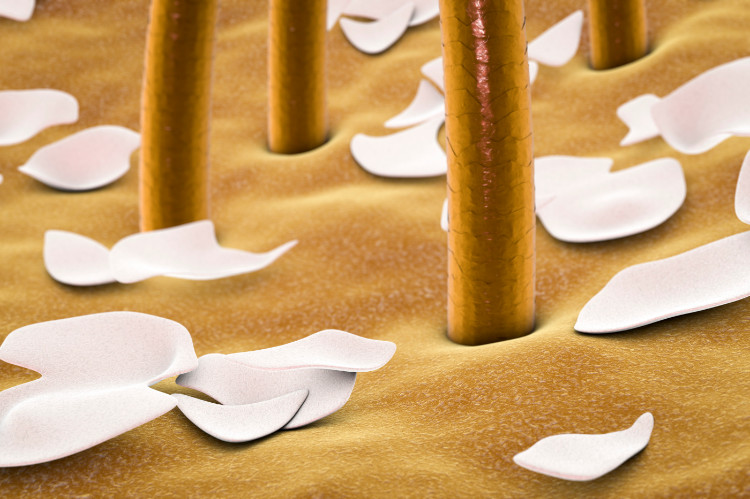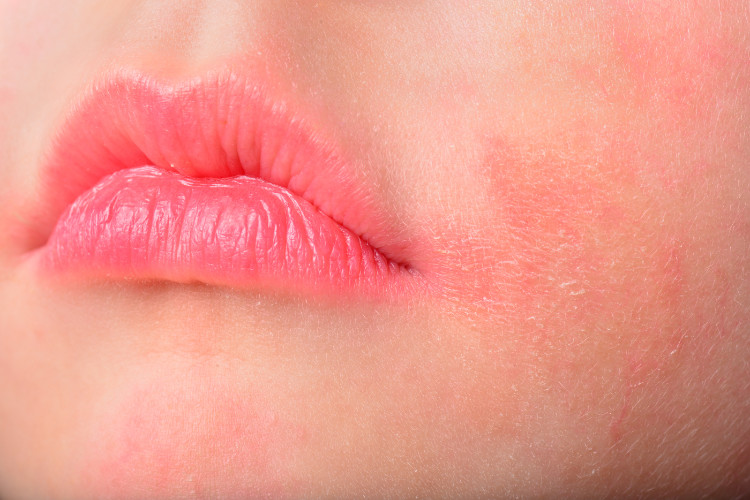Dandruff in the hair. Is it caused by oily hair or is the problem somewhere else?

It is said that hair is the crown of beauty. All of us would like to look good, and that is why we often visit hair salons. The aesthetic aspect is very important for people's lives today. However, more often than not, an aesthetic problem is very closely linked to a health problem. In the same way, dandruff in the hair, i.e. its excessive formation, can be triggered by various influences. In some cases, it can be a disease. Therefore, it is important to know what triggered the excessive formation of unaesthetic white scales in the scalp and, based on this, to take a stance on the solution and treatment.
Article content
A snowy coat on the shoulders and a lot of dandruff in the hair pleases no one. The best way to get rid of dandruff is to know the cause. Sometimes anti-dandruff shampoos may not be enough.
What is dandruff and how is it caused?
The superficial layer of the skin is called the epidermis. It is made up of several layers of cells. The peeling of the uppermost layers of the skin is a completely natural process. It leads to its renewal and physiological regeneration.
Physiology of dandruff

The old cornified epithelial cells shrink on the surface, peel off and are replaced by new cells from the deeper layers of the epidermis. This whole process of cell renewal takes about 20 days to 1 month and is constantly repeated throughout our lives.
Under certain circumstances, there may be a problem with their detachment. They stick in place and mix with sebum, sweat and water produced by the sweat and sebaceous glands. They become more oily and more visible as they accumulate. These resulting scales are called dandruff.
They are most commonly seen in the scalp. This is due to the localization of the sebaceous glands in the hair follicles or at the base of each hair or hair shaft.
Dandruff and its appearance
Dandruff is dead skin cells and everyone has it to varying degrees. About 50% of dandruff is not visible to the naked eye. However, this does not mean that it does not exist. The appearance and amount of dandruff can vary depending on the amount of sebum produced by the sebaceous glands, the hygiene habits of the individual, other diseases causing excessive production of dead scales and other factors affecting the scalp.
1. A dandruff is a thin, white-coloured scale of dead epidermis, usually oval to elliptical in shape. It occurs in clusters and falls off when peeled off. The dandruff is usually seen on the clothing around the shoulders. It gives the impression that the person suffering from excessive dandruff has 'snow-covered clothing'. Such dandruff is called dry dandruff. Hair should be washed less frequently and the use of oils is advisable.
2. When the production of sweat and especially sebum by the sebaceous glands is increased, dandruff turns yellow, is coarser, greasy and sometimes forms larger clumps or areas. It is difficult to get rid of them mainly because of the greasy consistency which makes them stick to the hair. This type of dandruff is called greasy dandruff. It is very unaesthetic. The hair of a person with this type of dandruff often becomes greasy even when washed frequently. Hair should be washed more frequently.
What are the causes of excessive dandruff formation?

The causes of dandruff are varied. It is often a combination of several influences at once. Genetic predispositions, mechanical irritation, chemical and physical factors that we consider to be common in hair styling, as well as various diseases - mainly dermatological - also contribute to the excessive formation of unpleasant scales in the hair. However, skin diseases also affect other parts of the skin, including the scalp.
Yeast
The main cause of dandruff is a yeast infection. The direct causative agent is the yeast Pityrosporum ovale. It belongs to the natural skin microflora and does not normally cause any problems. It is a yeast that feeds on sebum. In a suitable environment it multiplies and produces toxins that affect the skin through an inflammatory process. This results in dermatitis.
- People with more active sebaceous glands are at risk. Naturally, this mainly affects the male sex, which is why men have dandruff more often.
- It thrives well in warm and humid environments. Thus, another risk group is people with increased sweating, which is common for them, or increased sweating due to another disease cause.
- Last but not least, this includes immunocompromised people with immunosuppressive therapy. Increased dandruff formation has been noted in people suffering from AIDS as well as other immunodeficiency diseases.
- The overgrowth of yeast infection may also have a hereditary basis and stressors. In some people, dandruff appears at an increased rate during a certain stressful period and disappears again after it subsides.
Mechanical causes
With prolonged mechanical irritation of the head, the scales may flake off sooner than they should. Most dry dandruff is sporadic in occurrence. Other factors are involved at the same time. Rather, it could be said that mechanical causes only multiply the risk of dandruff from other causes. Once the triggering mechanism is removed, it quickly subsides.

- Mechanical irritation is usually caused by various headgear. We are talking mainly about hats, caps or scarves. Dandruff only occurs when these are worn regularly and for a long time, in combination with other influences (chemical, genetic...), but this may not be the case for everyone. Some people may not get dandruff even with mechanical irritation.
- Problems can also be experienced by workers who regularly use protective headgear during their occupation as part of their safety. Such occupations include doctors who wear nets on their heads during operations. Then there are construction workers, climbers, miners, soldiers, pilots who wear helmets because of the increased risk of head injuries. Caps or scarves are also used in other occupations, for example in the food industry, chemical industry and so on.
- Under the headgear, there is an increased accumulation of heat and moisture due to excessive sweating. Such an environment is ideal for the life and multiplication of yeasts and bacteria, whose activity causes infectious dermatitis. In this case, oily, hard-to-remove dandruff occurs in the hair.
- Dandruff causes an unpleasant itchy sensation. Itching of the head, for example due to excessive sweating, wearing a hat or an allergy or skin disease, then causes scratching, which multiplies the peeling of the upper layers of skin cells to form small white scales.
Physical causes
Hairdryers, curling irons, flat irons, crepe irons and electric curlers are popular hair styling tools, especially among women. These hair styling tools are used in hot weather, which results in damage and drying of the hair and the scalp. Regular 'hot styling' can result in small scales in the hair as a result of a very dry scalp.
Chemical causes
Not only heat, but also chemical influences play a role here. Using hair products that dry out the hair also damages the scalp during heat treatment. Chemical products include hair dyes, highlighters containing hydrogen peroxide, fixative hairsprays and lesser fixatives. They result in the formation of dry dandruff. Even some types of shampoo dry out the scalp.
Stress
Although stress has not been scientifically proven to be associated with excessive flaking of the superficial epidermis of the hairy part of the head, cases of recurrent dandruff formation by individuals during stressful periods with the disappearance of the problem during periods of calm have been reported.
Stress is a trigger for a large number of diseases, as people suffer from insomnia, chronic fatigue and a general weakening of the body and its defences, among other things. Weakened immunity gives yeasts, as well as bacteria and viruses, the opportunity to multiply excessively.
The most common diseases causing dandruff
Certain disease processes also cause increased skin peeling. These are mostly dermatological diseases. They affect the skin in general, drying it out, and usually forming eczematous deposits in which the skin is dry, cracked and falls off. The formation of dandruff is common in these diseases and is just one of many complications of a particular disease.
1. Seborrhoeic dermatitis

Seborrhea is one of the inflammatory skin diseases caused by the same yeast that multiplies on the head in a moist and warm environment when the sebaceous glands are overproduced. We are talking again about the yeast Pityrosporum ovale. The etiopathogenesis of the triggering of the disease and the overgrowth of the yeast is not entirely clear. Endogenous, hormonal, genetic and other influences are assumed. The affected areas of the body are those where the sebaceous glands are located. Mostly it is the area of the scalp, face and affects the trunk. On the face, the localization is specifically in seborrheic areas such as the forehead, eyebrows, nasolabial folds (the area between the nose and upper lip) and chin.
On the skin, local inflammation forms in the predilection areas due to toxic substances produced by the yeast infection. The skin is reddened in the affected areas with slight local swelling, cracking and peeling to an increased extent. The sloughed off skin scales are yellowish in colour and oily. The incidence is more frequent in winter and decreases in summer.
2. Atopic dermatitis

Atopic dermatitis, also known as atopic eczema, is a chronic, recurrent, itchy skin disease. In this disease, periods of improvement and deterioration of the skin alternate. The aetiopathogenesis is multifactorial. Genetic predispositions (allergy, atopic eczema), immunological and allergic factors, environmental influences, the presence of infection and defects in the fatty, skin barrier with consequent water loss, dehydration and skin breakdown are known.
It is manifested by itching (pruritus), reddening of the affected skin (erythema), local thickening (lichenification) and the formation of papular to vesicular efflorescences. The skin peels off at predilection sites, which are the sites of flexion such as the wrists, elbows, popliteal fossae, neck and head.
3. Psoriasis or psoriasis

Psoriasis is an autoimmune, chronic, inflammatory and the most common skin disease in humans. A genetic predisposition is assumed at the onset, which has been confirmed in about 30% of patients. The onset of the disease, or the first manifestation, takes place between the ages of 10 and 30. The term autoimmune means that the trigger is the patient's own immune system. As already mentioned, the skin renews itself in 20 to 30 days. In people suffering from psoriasis, this process is accelerated several times, causing the skin to peel more rapidly over a period of about four days. The disease has several forms. Mild to life-threatening courses can be observed.
It is normally manifested by inflammatory changes in the skin also in the predilection sites, which are the large joints (knee, elbow) or the head. In some patients, it may appear only on the head. The skin is red, palpably coarser with a rougher surface, cracked with a tendency to rapid cell division and scaling with the formation of scales.
4. Sweet scabs (impetigo vulgaris) and other bacterial infections
Skin scaling can also be caused by micro-organisms. One of the most well-known diseases caused by bacterial infection and manifested by excessive skin scaling is impetigo vulgaris. This is a disease typical of childhood. The causative agent is most often golden staphylococcus (Staphylococcus Aureus) or Streptococcus pyogens. The cause of the occurrence is bacteria, reduced skin resistance, micro-infections of the skin, but also neglected hygiene. The infection is transmitted by direct contact.

It is initially manifested by the appearance of erythema (redness) of small size in the head area. In the erythema, small vesicular formations filled with fluid are formed. After they burst, the fluid dries and forms small scabs of honey-yellow colour, which peel off. The honey-yellow colour of the scabs or scales is the reason why they are also called sweet or milky scabs.
Staphylococcus aureus is a resistant bacterium that mainly affects the skin and hair follicles. It causes skin infections in the hair and hair follicles - inflammation of the hair follicle. It can spread to varying degrees into the hair, where it forms pus-filled ulcerations that are painful, itchy and scratch during the healing process. Scratching spreads the infection and peels off the surface scabs and epithelia.
In addition to the diseases already mentioned, there are many other skin diagnoses that are manifested by dryness and peeling of the surface cells. Due to their extensiveness, only the most common ones that are most often encountered in everyday life have been listed.
Tip: In this article you will find a lot more information about dandruff and how to get rid of it.
Related










